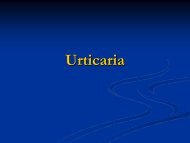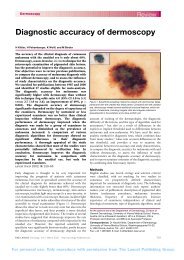Welcome to Dermatopathology - Dermatology
Welcome to Dermatopathology - Dermatology
Welcome to Dermatopathology - Dermatology
Create successful ePaper yourself
Turn your PDF publications into a flip-book with our unique Google optimized e-Paper software.
Goals and Objectives of Derma<strong>to</strong>pathology<br />
First-Year Residents<br />
1. Learn a general approach <strong>to</strong> his<strong>to</strong>pathologic diagnosis.<br />
DERMATOPATHOLOGY<br />
2. Be able <strong>to</strong> identify common cutaneous neoplasms (i.e. seborrheic kera<strong>to</strong>sis,<br />
malanocytic nevus, etc.) and common inflamma<strong>to</strong>ry patterns (i.e. spongiotic dermatitis,<br />
interface dermatitis, etc.) with reasonable reliability.<br />
3. Understand basic principles of gross pathology: how specimens are “cut in” and how<br />
that affects the practice of pathology.<br />
4. Understand fundamentals of clinicopathologic correlation.<br />
5. Be able <strong>to</strong> rationally explain the fundamental nature of disease processes (i.e. cysts,<br />
malformations, hamar<strong>to</strong>mas, hyperplasias, benign and malignant neoplasms, etc).<br />
6. For UC trainees, review the UCSF derma<strong>to</strong>logy resident slide set of diagnoses based<br />
on your year of training, and read on those as well.<br />
Readings<br />
Skin Pathology, David Weedon; contribu<strong>to</strong>r, Geoffrey Strut<strong>to</strong>n. 2nd ed. London; New York:<br />
Churchill Livings<strong>to</strong>ne, 2002<br />
Also see the Differential Diagnosis I through IV by A. Bernard Ackerman, available in our<br />
library.<br />
REVISED 6-23-2009 6
















